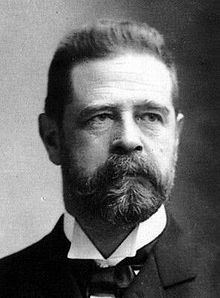Germán Riesco Errázuriz
Germán Riesco Errázuriz (born May 28, 1854 in Rancagua , † December 8, 1916 ) was President of Chile from 1901 to 1906 .
Riesco came from a wealthy merchant family. His uncle Federico Errázuriz Zañartu (his mother's brother) was Chilean president from 1871 to 1876.
After school Germán Riesco studied at the Universidad de Chile Law and passed the bar exam in 1875. As a student, at the age of only seventeen, he worked for the Ministry of Justice. In 1880 he married his cousin María Errázuriz Echaurren, the sister of Federico Errázuriz Echaurren , who served as Chilean President from 1896 to 1901.
He rose quickly in the judicial system and worked from 1891 for the Court of Appeal of Santiago and from 1897 as a public prosecutor for the Supreme Court of Chile.
Riesco sat in the Chilean Senate for the Talca region from 1900. In 1901, the Alianza Liberal, the moderate liberal-conservative , appointed him as a presidential candidate, which was viewed by the clerical-conservative newspaper "El Porvenir" as an "attack on religion". The violently angry dispute between liberal and clerical forces in Chile at that time can hardly be understood today. The mere fact that Riesco had been made a presidential candidate by the Liberals was enough for the priest of his local congregation to refuse absolution to the practicing Catholic after confession.
In the elections of September 1901 Germán Riesco achieved a clear majority and was elected President of Chile. The parliamentary system of government weakened the position of the president, who had to reshuffle his cabinet of radicals, liberals, democrats and Balmacedists (the supporters of José Manuel Balmaceda ) no less than 17 times at the behest of parliament. Riesco ruled with alternating majorities of the liberal Alianza Liberal and the conservative Coalición .
The lawyer Riesco directed the main focus of his policy on legal reforms. During his tenure, the Civil (1902) and Criminal Procedure Codes (1906) of Chile were passed. Santiago also received a sewage system and the electricity network was significantly expanded. In addition, the education system received important impulses: Here Riesco primarily had an impact on the establishment of secondary schools (also for girls) and teacher training.
His financial policy was less forward-looking. The Riesco government was forced to worsen the precious metal content of the coin currency and thus significantly devalue the peso, which led to an increase in inflation in Chile. A wave of speculation swept through Chile and shook the Chilean economy.
The Riesvo government also faced a tough test in terms of social policy. With industrialization, social contrasts intensified. Farm workers sought their fortune in the factories and the saltpeter mines, but encountered devastating working and living conditions there. Strikes and workers' uprisings in many industries were the result and further weakened Chile's already poor economic performance in the years 1903 to 1905. The needs of the workers met with little interest from the leading politicians, who came almost exclusively from the country's small upper class.
On October 22, 1905, there were general protests in Santiago against the rise in meat prices , the so-called Huelga de la Carne (English: meat strike). Beef, a staple of Chilean cuisine , had become so expensive that many of the poor found it unaffordable; More and more people marched from the Pacific towards the capital, until in the end around 30,000 demonstrators marched in front of the La Moneda presidential palace . The military responded with violence against the riots, at the end of the Semana Roja (dt .: red week) over two hundred deaths were to be mourned.
In February 1906, events repeated themselves in Antofagasta , when about three thousand demonstrators supported the railroad workers' demands for higher wages and better working conditions. The military again violently suppressed the protests. In the subsequent debate in the House of Representatives, 58 dead were mentioned.
In terms of foreign policy, however, the Riesco government was able to ease the conflict with Chile's neighbors. At the beginning of Germán Riesco's presidency, the country was on the verge of war with Argentina because of the controversial border drawing in Patagonia . Both countries had already mobilized their reservists, but two treaties dated May and November 1902 resolved the disputes. Chile signed a peace and friendship treaty with Bolivia in October 1904, but the relationship between the two states remained tense, and the land border with Bolivia is still equipped with landmines in some places . In 1906 Chile also established diplomatic relations with Peru after relations with both neighbors had been extremely poor in the wake of the Saltpeter War and the Chilean conquests in the north ( Antofagasta and Arica had been annexed by Chile a few years earlier).
While President Riesco tried to balance things out in the north of the country, Chile continued to expand towards the south and planned the expansion of the territory with ambitious plans to colonize the Antarctic .
Shortly before the end of Riesco's tenure, a severe earthquake shook the Valparaíso region on August 16, 1906, almost completely destroying the city and its surroundings. The telegraph lines were cut and the infrastructure paralyzed.
Riesco's successor Pedro Montt Montt had to cope with the reconstruction . Germán Riesco Errázuriz retired from political life after his tenure and died of a heart attack at the age of 62 on December 8, 1916.
See also: History of Chile .
Web links
| personal data | |
|---|---|
| SURNAME | Errázuriz, Germán Riesco |
| BRIEF DESCRIPTION | Chilean politician |
| DATE OF BIRTH | May 28, 1854 |
| PLACE OF BIRTH | Rancagua |
| DATE OF DEATH | December 8, 1916 |
